
|

|
|
Home Site Search Contact Us Subscribe
|
|
|
Architects EAT Melbourne How things are panning out on Melbourne's burgeoning skyline is questionable. But in the shadow of those weird towers, firms like Architects EAT are doing work that is subtle, refined, location-appropriate, and very beautiful. By Jonathan Lerner August 20, 2013 The Victorian- and Edwardian-era buildings in Australian cities like Melbourne, echoing those of Britain, were highly ornamented. Typical terrace houses, even tiny ones, dressed themselves up with wrought iron filigree; cartouches on their parapets announced grandiose names like “Somerset” and “Anne’s Villa.” In the same spirit, commercial blocks were crenellated and corbelled and otherwise elaborated. Nevertheless, Australia came to produce a distinctly austere Modernism. It originated in the functional vernacular of a country that was, until recently, less than wealthy, and in response to the continent’s vast landscape and harsh climate. This was an architecture of clean-lined, unembellished structures – houses built of workaday materials like weatherboard and corrugated metal, with big windows, natural ventilation, outdoor access, and long views. A Bauhaus influence, arriving in the 1940s with European immigrants, added sophistication but hardly conflicted with that aesthetic.
Australia has escaped the worst of the Great Recession, and Melbourne – with over four million people, the second largest city – is enjoying a development boom. In architect-designed single houses and in additions to old terrace houses, the minimalist, environmentally responsive Australian-Modern sensibility prevails. But many larger projects there – office and apartment towers, cultural and university buildings – present a riot of bewildering and frequently awful design. Unsettling fractal facades, clashing saturated colors, weird biomorphic excrescences – a visitor starts to wonder whether delirium is epidemic in the local development community. “There are two quite distinct schools of architects here,” says Albert Mo, a principal of Architects EAT, a studio formed in 2000 that is gaining prominence in Melbourne and the region beyond. “One is what we call the ‘straight-line architects’ – like, ‘We never do a single curve or angled wall.’ The other one is more expressive and experimental, whether it’s crazy composition, or more organic sculptural form.” Mo and his colleagues don’t shy from experimentation, and may actually do the occasional curve or angled wall. But their work is firmly grounded in restrained Australian Modernism. It well exemplifies that of their generation, too – of its grounded members, anyway.
That doesn’t mean Architects EAT lacks playfulness. Their recently completed Pulse Apartments is a pair of trim, rectilinear five-story buildings composed of predominantly horizontal elements in concrete, glass, and steel. The modules themselves and the grid they form are reminiscent of Mies van der Rohe’s iconic designs for the Illinois Institute of Technology. A graphic, devised for EAT’s web page about the project, repeats a photo of van der Rohe, turned sideways and roughly duplicating the pattern of the buildings’ façades. The caption? “Stacking Mies.” EAT’s home page also links to Andy Warhol’s film “Eat,” a static black-and-white head shot of the artist Robert Indiana eating for 45 silent minutes – a more ironic comment on the modern world would be difficult to find. (Their name, chosen for its memorable idiosyncrasy, represents the first initials of the founders’ names; “E” for Eid Goh, “A” for Albert Mo and “T” for a long-gone former colleague. James Coombe, now the third principal, joined in 2005.)
Many old Melbourne neighborhoods, with their intact building stock, agreeable pedestrian scale, and excellent transit are desirable again – and gentrifying. Stroll their back alleys and you’ll see sleek contemporary additions slotted into the narrow rear gardens of those flamboyant little row houses. Like many young firms, EAT got its start designing backyard extensions. They still do a few, but “of much larger scale, a few million dollars’ difference,” says Mo. A recent example is the expansion of a free-standing Edwardian cottage, a project they call Elm & Willow for two trees dominating the garden that – beyond being preserved – gave the design its rationale.
The existing house was restored – fussy fretwork, leaded glass and all – but its interior was scrubbed of color; it has white walls uncluttered by art, and bleached plank floors. At the end of its long central hall a translucent door slides away to reveal the addition. Two transparent pavilions, parallel rectangles, define a graveled court in which one of the big trees spreads. Their concrete floors float above grade to not interfere with the root systems. Their walls are large glass panels that roll open, atop which float flat concrete ceilings, impressed with the wood grain of their forms. The first pavilion is a living area, while the further one, through which a garden at the back of the lot is visible, contains the kitchen, dining area, and deck. A service corridor that links the two spaces, hiding a bathroom, laundry, and rear entry, seems opaque, with a black wall facing the courtyard. But that wall is composed of louvres that render it, too, wide open and seamlessly part of the indoor-outdoor flow.
“Maybe because there’s so much damn land out there, and we love it,” says Coombe. “The ideal, high goal for a lot of architects is to do a single house monumentally stuck in the middle of the bush.” That’s a reference to work by Australian-Modern pioneer Glenn Murcutt, who has been a strong influence on the country’s younger architects. In practice, such commissions are few. But EAT still expresses that relationship to the outdoors, with houses like Elm & Willow in more urban contexts. Response to environment is also right on the surface of a 10-story apartment building the firm designed, which is being completed now; for its façade, a system of motorized louvres will open and close depending on sun angle and weather.
“They represent an emergent generation of Australian architects who are less interested in functional steel sheds, obsessively repetitive elements, or the complexities of a one-liner,” says Martyn Hook, Melbourne editor of Architectural Review Australia and professor of architecture at the Royal Melbourne Institute of Technology. “These younger architects like EAT are interested in a richness of space, an appropriate but sustainable response to context, and a celebration of the opportunities that living in Australia presents not only in climatic terms, but also in social engagement and affluence.”
These days few of their projects are additions, but having done so many, and now undertaking multi-unit buildings in tight city locations, “we’re used to working within constraints,” Coombe says. “It’s quite funny. When we have a clean slate we have difficulty finding the basis.” That might be because they approach a project inquisitively, rather than with a signature idiom or toolkit of ready solutions.
Mo says their concern is for “the tactile quality of a building, where the touch and material, the sound, the light that comes in, is far more important than the stylistic quality. It’s about the journey through the building and through the seasons, ingrained into your memory. That is how we initiate our design process. We always think, ‘What do we want our clients to remember?’ A lot is site-specific. And the human context plays a really important part. We want the building to feel like our client.” EAT’s projects may not look much alike, but they share a close attention to detail – “how junctions work,” says Coombe, “the way welds are on a steel beam, the way the pulls are mounted on a drawer, how the materials come together. And texture. We want you to touch this wall and feel how it’s different from another place – for example using rough, recycled wharf timber to offset some really sharp concrete. It’s our holistic view.”
EAT’s practice in the early years was mainly residential, plus the occasional retail interior. Then came what Mo calls “a great architect-got-the-job story.” He went to meet a potential client who wanted his penthouse remodeled. “He opened the door, a really young kid, and I was like, ‘Oh, maybe I shouldn’t have taken the call.’ I was quite blunt, ‘We are not the cheapest around.’ He said, ‘Fine, let’s go.’” The kid’s father turned out to be a shopping center developer in the Philippines, who liked what they were doing for his son. He hired EAT to design a bowling center. They’ve been working for him ever since. Of the three principals, Goh focuses on retail and hospitality design, while Coombe and Mo handle the residential jobs. Goh says, “We tend to not cross-pollinate between them because they’re so different.” That goes beyond the distinction between public and private to include clients’ motives – profit center or place to live? – and projects’ life expectancies, with hospitality venues, for example, typically being redone every few years. “Unless you are designing a hotel, where I think the essences of both commercial and residential work cross paths,” he adds. Their first chance to verify that conjunction is now on the boards, a seven-story boutique hotel project in Bali.
EAT’s Philippine connection was a lucky break, but it reflects Australia’s increasing interconnection with its Asian neighbors. Investors from Asian countries are participating in Melbourne’s construction boom, and it’s not so remarkable that several people at EAT speak fluent Chinese – “not that it gets us more clients, but when we’ve got a job, we can communicate,” says Mo. Indeed, the ethnic backgrounds of the 11 people in the office reflect Melbourne’s vibrantly multicultural population. The families of only two originated in Britain; two came from China, one from France, one from Spain, one from Ireland, two from Singapore, one from Indonesia, and one from Hong Kong. Three are immigrants themselves. “The element that I find particular in their work is the fact that their Asian heritage presents them with a very contemporary understanding of Australia's position,” observes Hook. “Their surprisingly efficient use of space and the careful approach to detail suggest to me perhaps an innate working method that is culturally specific.”
The cosmopolitan mix reflected by Architects EAT, and perhaps a sibling rivalry with prettier but stuffier big sister Sydney, give Melbourne an open, boundary-testing culture. It’s the edgier place for art, fashion, literature, cuisine, cocktails – and architecture. “People run with things a bit more, they’re willing to see how things pan out,” says Coombe. How things are panning out on Melbourne’s burgeoning skyline is doubtful. But in the shadow of those weird towers, architects like EAT are doing work that is subtle, refined, location-appropriate, and very beautiful.
Jonathan Lerner’s articles on architecture, urbanism, and design have appeared in Landscape Architecture, Metropolis, Pacific Standard, Modern, Oculus, and many other design and mainstream magazines. He is also a communications consultant to design professionals and developers at www.urbanistcommunications.com. |
(click on pictures to enlarge)  Architects EAT Pulse Apartments: “Stacking Mies” repeats a photo of Mies van der Rohe turned sideways, which roughly duplicates the pattern of the buildings’ façades. 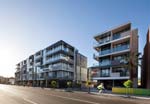 John Gollings Pulse is a medium-density residential development in the beachside suburb of St. Kilda that includes 101 units in two five-story buildings with ground-floor retail and hospitality.  John Gollings Pulse detail. 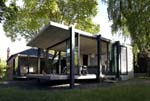 Earl Carter Elm & Willow House: the two trees – beyond being preserved – inspired the design rationale for a new addition to an Edwardian cottage that, itself, was restored. 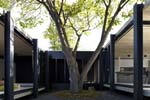 Earl Carter Elm & Willow House 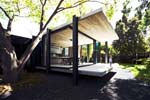 Earl Carter Elm & Willow House 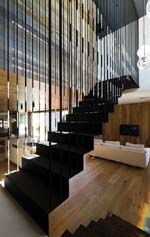 James Coombe Open House, designed for a professional couple, retained the existing envelope with the design focus shifted to the interior spaces. 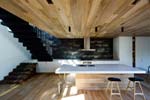 James Coombe Open House 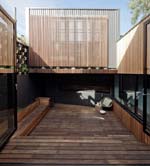 James Coombe For Parure House, instead of the modern backyard extension commonly added onto Melbourne's typically narrow historic cottages, a new second structure at the rear of the lot contains a master suite above the jeweler-homeowner's sunken studio. 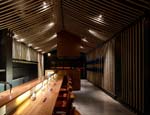 Derek Swalwell The multi-award-winning Maedaya Bar is a Japanese Izakaya bar with a focus on recycled materials that includes using manila ropes to achieve simplicity in spatial form. 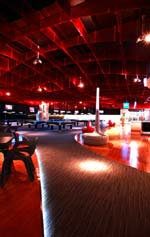 Lito Lopez Mall of Asia Bowling Center, Manila |
© 2013 ArchNewsNow.com